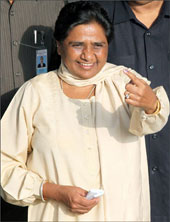 | « Back to article | Print this article |
Mobile phone helped Mayawati win 2007 UP polls
 Mobile phones are big business in India, and according to two Australian researchers evidence has emerged that this instrument played a key role in helping the Bahujan Samaj Party and its leader Mayawati achieve a resounding electoral victory in the country's biggest state -- Uttar Pradesh -- in 2007.
Mobile phones are big business in India, and according to two Australian researchers evidence has emerged that this instrument played a key role in helping the Bahujan Samaj Party and its leader Mayawati achieve a resounding electoral victory in the country's biggest state -- Uttar Pradesh -- in 2007.
In the three years since, Mayawati has entrenched herself as a powerful player in national politics, according to Australian researchers Robin Jeffrey and Assa Doron, who are exploring how India's mobile phone boom has helped parties representing the bottom rung of the caste system do well at the ballot box.
The number of mobile subscribers has surged from just 1.2 million in 1999 to almost 600 million.
About 20 million new subscribers are being added every month, making India the world's fastest growing phones market.
In 1987 there were only 0.3 phones for every 100 Indians, now there are 51.
Fierce competition between telephone companies has driven down the prices of handsets and calls and allowed millions of poor families access to a phone for the first time. Call tariffs dipped below 1 cent per minute in the past year, analysts say.
The growth in mobile phone use has caught authorities by surprise. A 30-year numbering plan drawn up in 2003 is already outdated and analysts say the number of digits in all Indian mobile phone numbers will soon have to be increased from 10 to 11.
Subscribers have doubled since August 2008 and there are now 10 times more mobiles in India than fixed lines.
Analysts say mobile phones have affected every strata of Indian society like few tools ever have. Advertisers have portrayed the mobile phone as a household essential for the poor -- alongside shelter, food and clothing.
Studies have shown how mobiles have helped poor Indian farmers to avert losses and improve yields.
With buyers just a phone call away, they can adjust their production to suit demand; easily accessible weather forecasts help with crop planning.